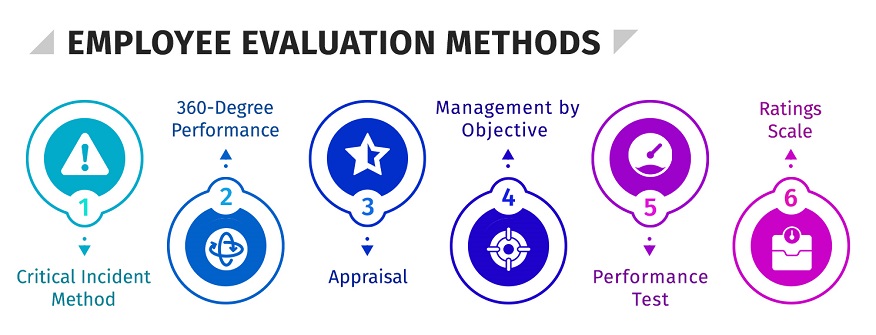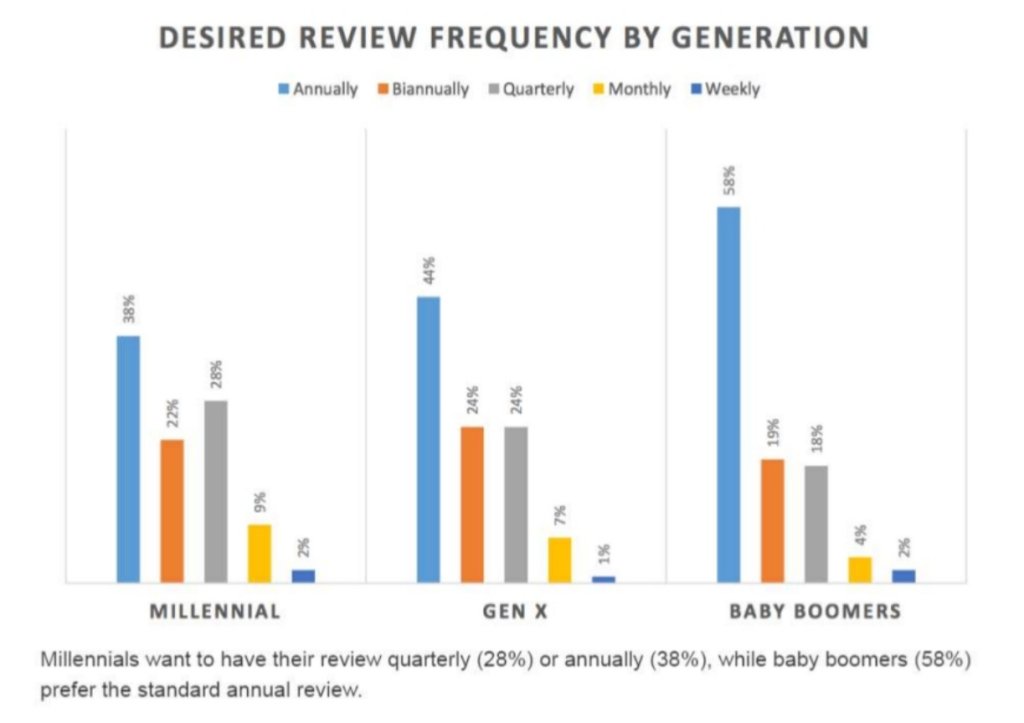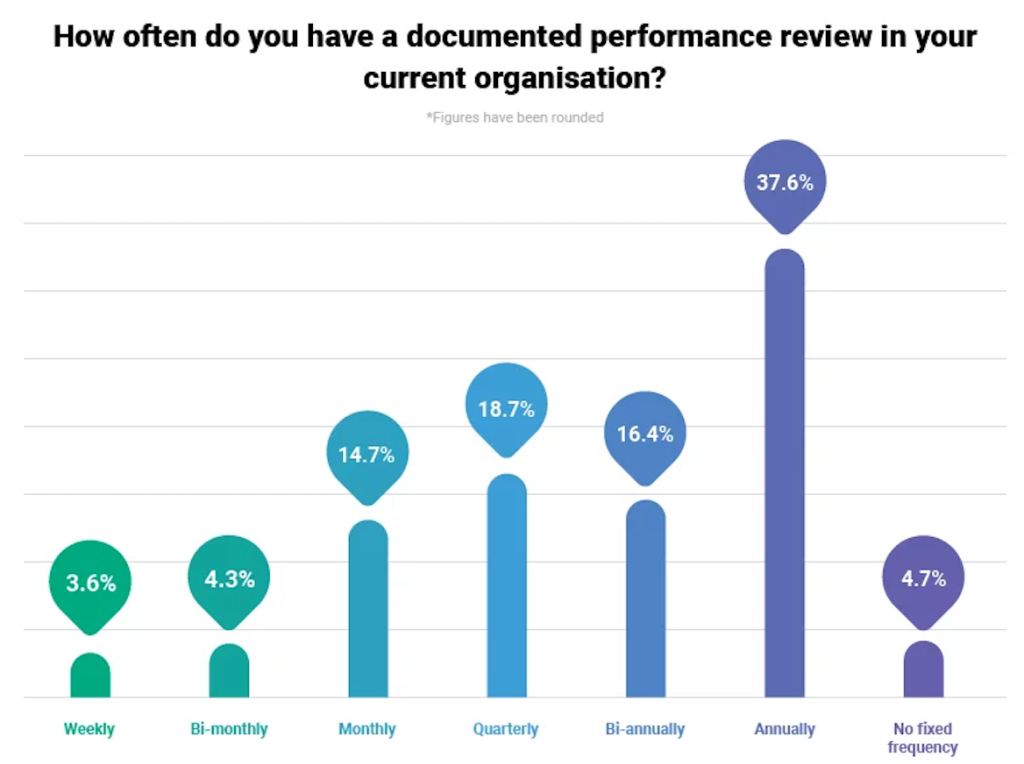
Employee performance reviews are a formal process for evaluating and documenting an employee’s performance. This process allows employees to receive feedback on their performance, where they can recognize their areas of strength and improvement.
Another thing that a performance review does is help set goals and objectives for the employee to work towards in the future.
The performance review also provides an opportunity for employees to provide feedback on their performance. This review should also include an assessment of the employee’s strengths, weaknesses, and potential. The reviews should conclude with a plan of action for the employee to take in order to improve their performance.
Performance Evaluation Methods
One can employ the following methodologies to conduct a performance evaluation review:

1. 360-Degree Feedback: As the name suggests, this evaluation involves collecting feedback from everyone involved in the business. Be it an employee’s peers, subordinates, supervisors, or even customers.
2. Goal Attainment Methodology: Such evaluation involves setting measurable performance goals for the employee and then evaluating their success in reaching those goals.
3. Forced Ranking Methodology: This type of evaluation ranks employee performance in comparison to that of their peers.
4. Checklist Methodology: A checklist evaluation involves using a checklist of competencies and rating the employee’s performance on each.
5. Behavioral-Based Methodology: In this, we focus on specific behaviors that an employee demonstrates and evaluate the employee’s effectiveness in each.
6. Self-evaluation: This type of evaluation involves allowing the employee to assess their own performance.
7. Results-Oriented Methodology: This type of evaluation looks at the results that the employee achieves rather than their specific behaviors.
ALSO READ: Focus on Mental Health Awareness in the Workplace Performance Evaluation Types
Every organization or business has a certain type of evaluation based on its policies or industry category. The following are the types:

Weekly Performance Review
Weekly performance evaluations are most beneficial when employees are just starting out in their roles or if the role is complex and requires ongoing feedback and development.
This allows for more frequent dialogue between managers and employees about their performance and progress against their objectives.
Monthly Performance Appraisals
Conducted on a monthly basis, it allows the managers to assess and track the progress and performance. During the evaluation, the manager will assess an employee’s job performance in relation to predetermined goals and objectives and provide feedback on their successes and areas for improvement.
This evaluation may also include a discussion of any issues or challenges the employee might be facing and what steps can be taken to counter them.
Quarterly Performance Evaluation
Quarterly performance evaluations are an important way to provide employees with feedback on their performance. Managers that take the time to examine their employees’ performance once a year are in a position to offer both praise and suggestions for how they may improve.
They provide employees with an opportunity to receive detailed feedback on their performance and how it compares to their goals and expectations. During the evaluation, supervisors and employees can discuss successes and challenges and set goals for the coming quarter.
Quarterly performance evaluations are also a great way to recognize and reward employees for their hard work and contributions.
Annual Performance Review

As the name implies, the annual review is the culmination of the company’s assessment of an employee’s work over the course of a year. A purpose of an annual performance evaluation is to give an opportunity for managers to offer feedback to their employees, as well as to assess their performance and identify areas for improvement.
The evaluation typically consists of a review of the employee’s job performance and achievements over the year. Managers can provide constructive criticism and insight into how they might better serve their staff by conducting annual performance reviews.
ALSO READ: 40+ Employee NPS Survey Questions: How to Improve Workplace Satisfaction Advantages of Performance Evaluation
Conducting performance evaluations offers the following advantages to managers and employees.
1. Improved Performance: This allows workers to evaluate their performance, pinpoint areas for growth, and take action to achieve those goals.
By offering feedback and guidance, managers can help employees understand how their performance affects the success of the organization.
2. Increased Morale: Providing employees with a sense of recognition and accomplishment. Knowing their efforts are acknowledged and appreciated can boost morale, motivation, and productivity.
3. Increased Accountability: Helping to keep employees accountable for their performance. These regular assessments allow managers to track progress, identify areas for improvement, and ensure that employees are meeting their goals and obligations.
4. Improved Communication: Performance evaluation provides a platform for effective communication between managers and employees. Managers can discuss performance, provide feedback, and identify potential solutions through open dialogue.
5. Increased Retention: Building relationships between employees and managers. By recognizing and rewarding employee contributions, managers can foster loyalty and increase retention rates.
Common Mistakes in Performance Reviews
The managers should avoid using the following statements while conducting a performance evaluation.
1. “You’re not meeting expectations.”
2. “Why are you lazy?”
3. “I need you to buck up!”
4. “Clearly, you haven’t made enough contributions.”
5. “Leading a team will be difficult for you.”
6. “I’m afraid you are not suitable for this position.”
7. “You don’t live up to your potential.”
ALSO READ: The Art of Writing Effective Overall Performance Review Comments How Should a Sample Performance Evaluation Look Like?
The performance evaluation sample outlines how to assess an employee’s performance over the past year. It includes a series of questions related to the employee’s work performance, such as their:
- strengths,
- areas for improvement,
- overall job performance rating.
There should be a section on the performance review for employees to provide comments and ideas on their work and the firm as a whole.
The purpose of these reviews is to help companies analyze employee performance objectively and provide workers with helpful recommendations on how to improve.
Summary
To sum up, a performance evaluation analyzes an employee’s work based on predetermined standards. The supervisor or manager generally conducts such an assessment. But that can be done regularly, such as every week, month, year, or quarter.
It can help employers determine whether employees are meeting expectations, identify areas for improvement, and provide constructive feedback to employees. Above all, performance evaluations can also be used to inform decisions about salary increases, promotions, and disciplinary action.
Not Sure Where To Begin?
Explore our solutions to discover what is most important to your customers,
clients, and prospects. And best of all – it doesn’t take any coding!
Free Trial • No Payment Details Required • Cancel Anytime




